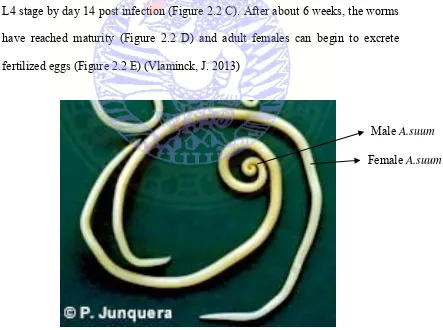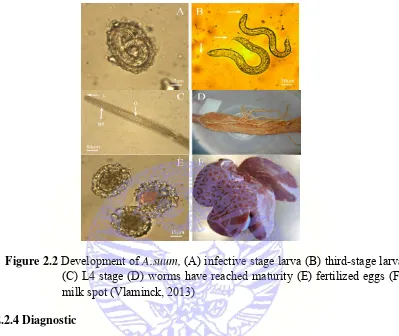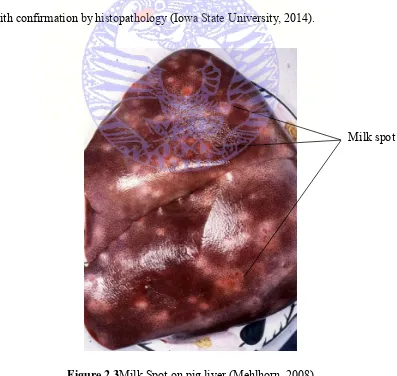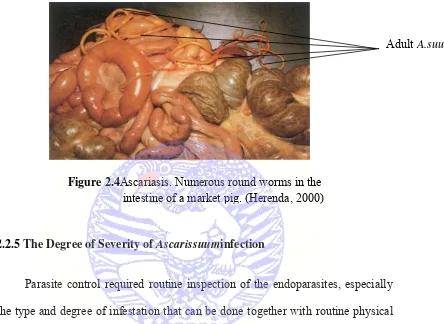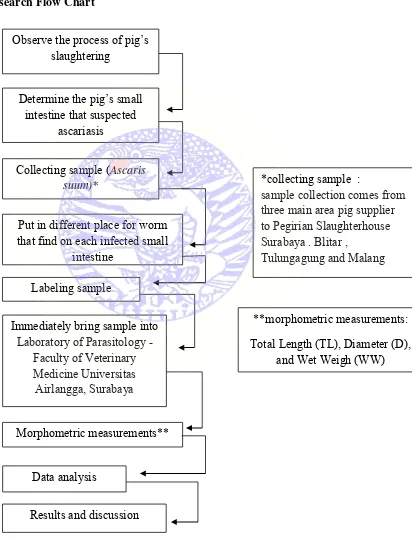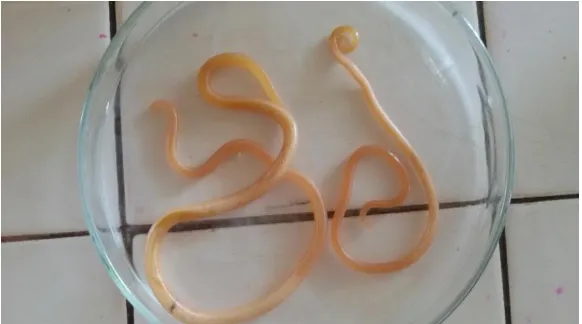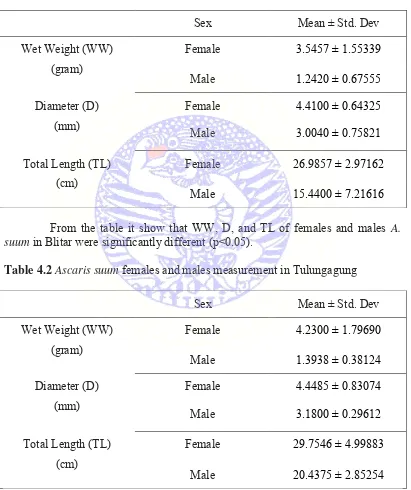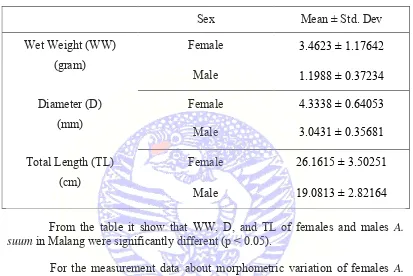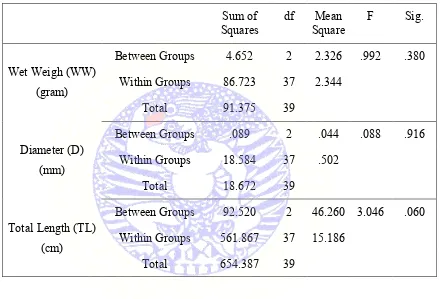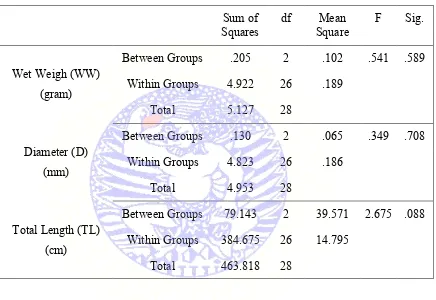SLAUGHTERHOUSE SURABAYA
By : GHEBY INDIRA
NIM 061111182
FACULTY OF VETERINARY MEDICINE UNIVERSITAS AIRLANGGA
ii
ENDORSEMENT FORM
Morphometry Variation of Male and Female
Ascaris
suum
at Pegirian Slaughterhouse Surabaya
Thesis
Submitted in partial fulfillment of the requirement for the degree of Bachelor of Veterinary Medicine
at
Faculty of Veterinary Medicine, Universitas Airlangga, Surabaya
By : GHEBY INDIRA
061111182
Approval of Supervising comitte
Prof.Dr. Setiawan Koesdarto, drh., M.Sc.
iii
MORPHOMETRY VARIATION OF MALE AND
FEMALE
Ascaris suum
AT PEGIRIAN
SLAUGHTERHOUSE SURABAYA
There is no other work ever published to obtain a college degree in a certain college and to my knowledge there is also no work or opinion ever written or published by others, except those in writing reffered to this paper and mentioned in the references.
Surabaya 30th November 2015
iv It has been assessed in research result seminar Date : January 5 th 2016
RESULT SEMINAR ASSESSMENT COMMITTE
Head Advisor : Prof. Dr. Nunuk Dyah Retno L, drh., M. S. Secretary : Dr. Kusnoto, drh., M.Si.
Advisor member : M. Yunus, drh., M.Kes., Ph.D.
v
THESIS ASSESSMENT COMMITTE
Head : Prof. Dr. Nunuk Dyah Retno L, drh., M. S. Member : Dr. Kusnoto, drh., M.Si.
M. Yunus, drh., M.Kes., Ph.D.
Prof. Dr. Setiawan Koesdarto, drh., M.Sc. Didik Handijatno, drh., MS., Ph. D
Surabaya, January 5 th 2016 Faculty of Veterinary Medicine
Universitas Airlangga Dean,
vi
MORPHOMETRY VARIATION OF MALE AND FEMALE Ascaris suum
AT PEGIRIAN SLAUGHTERHOUSE SURABAYA
Gheby Indira
ABSTRACT
Ascaris suum is a parasite nematode that causes infection in swines with
high prevalence rates in host populations and usually associated with liver damages called “milk spots” caused by larvae migration, resulting in organ condemnation. The study of morphology has had an important emphasis by developing statistical shape analysis. This study aimed to determine the variation of female and male Ascaris suum morphometry in Pegirian Slaughterhouse
Surabaya. This study used three region which is the main supplier of swine at Pegirian Slaughterhouse Surabaya. This study used 12 swine in each region and
took all of Ascaris suum that had been found in small intestine. The observations
of Ascaris suum morphometry were done after measured each of worm in ; Wet
Weight (WW), diameter (D), and Total Length (TL). Based on the data analysis, morphometry measurement between male and female Ascaris suum in each region
have significant different. The variation of morphometry affected by sex, not region. It can be seen from the size of WW, D, and TL that had significant difference (p < 0.05) for each sex. Region does not given an affected on morphometry variation of male and female Ascaris suum.
vii
complete the thesis entitled Morphometry Variation of Male and Female Ascaris suum at Pegirian Slaughterhouse Surabaya. The authors recognize that the
implementation of research until the completion of the thesis because of help of many people , on this occasion the author would like to thank to :
Dean of the Faculty of Veterinary Medicine, Universitas Airlangga Prof. Dr. Pudji Srianto., drh., M.Kes. for the opportunity given to the author to take a part in education in the Faculty of Veterinary Medicine, Universitas Airlangga.
Prof.Dr. Setiawan Koesdarto, drh., M.Sc. as the supervisor and Didik Handijatno, drh., MS., Ph. D. as co-supervisor and thank you for your time in providing guidance and useful advice from the beginning to the end of the study to complete of the thesis.
Prof. Dr. Nunuk Dyah Retno L, drh., M. S., Dr. Kusnoto, drh., M.Sc., and M. Yunus, drh., M. Kes., Ph.D., as the examiner thesis, thanks for the advice and input that given to the author for the perfection of this thesis.
Dr. Suharsono, as guardian lecturers and also the entire faculty staffs of the Faculty of Veterinary Medicine, Universitas Airlangga who have helped and provide knowledge to the author during the education at the Faculty of Veterinary Medicine, Universitas Airlangga.
viii
Rendy Gamal Naser, and also author’s special person Burhan Hamdani, and the whole author’s big family, thank you for your pray, patience and assistance provided during this study.
Thanks to Reno Aditya for always support and patience helped the author. And thank to my friends who helped complete the thesis Abe Suryansyah, Revo Astrawan, Tutuk W., Asri Ayu, Rizal Maulana, Yayan , and Dyaksa. Author’s International class mates 2011, Ogen Sea, Gita Fatmawati, Dinar Puspitasari, M. Imam H., Anisah Octaviany, Ihsan, Kemala, Diana, M. Hasan, Vidi, Bayu Digka, Tripurna, KarinaR., Firdausy Kurnia, Alif Aida, Gavrila A., Inanda Ayu, Monica Sally, Vanya A., Dona A., Elsa Leonita, Hadi M. H. , Ristaqul Husna, Kartika Purnamasari, Pavitran, Ari P. , Hening Tyas, Benda Alifianti, Evan Grady and Lilian, thank you for our friendship during the study, see you on top. Thanks to all of author’s friends in Faculty of Veterinary Medicine, Universitas Airlangga, who can not mention one by one, thank you for all of support, help, pray, cooperation, and time given to the author.
The author realize that this thesis is far from perfect, for that the author expects criticism and suggestions from readers. Finally, the authors hope this thesis can be particularly useful for writers and readers and can provide positive contribution in the field of Veterinary education and as source for further research.
Surabaya, November 2015
x
4.3 Decission Tree Analysis……… 24
CHAPTER 5. DISCUSSION ... 26
5.1 Morphometry of Ascarissuum... 26
5.2 Composition Males and Females of Ascarissuum ... 27
CHAPTER 6. CONCLUSIONS AMD RECOMMENDATIONS ... 30
6.1 Conclusions ... 30
6.2 Recommendations ... 30
SUMMARY ... 31
REFERENCES ... 33
xi
2.2 Life cycle of Ascaris suum ...………. 10
2.3 Milk Spot on pig liver ……….. 12 2.4 Ascariasis. Numerous round worms in the intestine of a market pig... 12 4.1 Male and female Ascaris suum that had been found at Pegirian
Slaughterhouse Surabaya………. 18
4.2 The bar chart of composition of male and female Ascaris suum
among regions ………. 23
4.3 Diagram of decision tree regression analysis ………. 24
xii
TABLE LIST
Table Page
xiii
1. Measurement Result of Morphology Males and Females A. suum at
Pegirian Slaughterhouse Surabaya………... 37
2. Measurement Result of Females and Males A. suumin Blitar………. 41
3. Measurement Result of Females and Males A. suum in Tulungagung…… 42
4. Measurement Result of Females and Males A. suum in Malang…………. 45
5. Morphometric variation of females A. suum between regions (Blitar ,
Tulungagung and Malang)………... 48
6. Morphometric variation of females A. suum between regions
(Blitar,Tulungagung and Malang)……… 49
7. Composition Females and Males Among Regions……….. 50
8. Decission Tree Regression Analysis……… 53
xiv
ABBREVIATIONS AND SYMBOLIC MEANING
e.g. : Exempli gratia (for example)
% : Percent
cm : Centimeter et al : Et alii ml : Mililiter
mm : Milimeter
mg : Milligram
NaCl : Natrium Chlorida
1
foods, other parts of the livestock can be used are skin, feces, and bones. One of the livestock that is also popular in tropical areas such as Indonesia is a pig. Pigs are highly efficient meat source, so pigs have a high economic value as livestock. In fact, pigs can be fed well, using only kitchen scraps from a family’s household (FAO, 2009). Other advantages why pork meat became popular for human consumption is it very rich in vitamin B6, B12, thiamine, niacin, riboflavin and pantothenic acid, and also it a source of iron that is easily absorbed than other meat sources. Pork meat also have a high mineral content of phosphorus, selenium, sodium, zinc, potassium and copper.
According Murtidjo (1993), the increasing of population, the demand for meat consumption will increase too. The importance of the meat production in the swine industry is reflected in some figures: From 1977 to 1998, world pork meat production had nearly doubled in 20 years (1977: 42.9 million tons of pork, 1998: 83.6 million tons of pork, data from FAO review, RDA Cameron, 2000) and since then pork meat production increased further till today, particularly in countries of Asia, e.g., in China (Mehlhorn, 2008). To meet these needs, it will require livestock development efforts and prevention of disease in livestock. Disease prevention efforts are intended to keep the animals healthy.
2
worms that can infect pig is Ascaris suum (A. suum). Ascaris suum is a very
common parasite of pigs. Swine ascariasis interferes with health and performance of swines while resulting in reduced feed to gain ratios and liver condemnation incurring economic losses (Stewart et al., 1988). Weaners and fattening pigs are
often infected with A. suum (Mehlhorn, 2008).
Post mortem inspection, the liver shows varying degrees of fibrosis, which may localized in the form of “milk spots”, these are usually whitish in colour but may become haemorrhagic, indicating a more recent nature (Soulsby, 1986). “Milk spots” caused by larvae migration, resulting in organ condemnation. Its importance is related both to the sometimes very significant lesions caused by larvae during migration through the liver and lungs, and to the effects of adult worms in the small intestine. In the liver, the traveling larva causes intra lobular necrosis and a granulation reaction known as “milk spots.” In the ordinary moderate infections, adults have no defined pathogenesis. In heavy infection, there is experimental evidence of reduction in growth rate, diarrhea, and ill thriving. Intestinal obstruction is rare (Mehlhorn, 2008).
Adult A. suum is the largest nematode occurring in pigs, very stout, white;
(Ballweber, 2001). There are have three prominent lips surrounding the mouth (Baker, 2007). Morphology of A. suum generally been described other than by
Ballweber (20011), Baker (2007), Cameron (1958), Ma’arif (1995), Soulsby (1986), Noble,W. and Noble, G. (1989), and Griffiths (1978). Acording Soulsby (1986) and Griffiths (1978), male length of A. suum 15 – 25 cm and for female 40
Include in gastro-intestinal nematodes (Over, et al. 1992) which means these
worms live in the human digestive tract. When existing infestations of A. suum
excess, it is not rare that worms will be pushed to other areas outside of the main predilection. This worm has a body that is symmetrical from tip to tip of the anterior posterior (Ma’arif, 1995), which distinguishes with other nematodes in pigs. Over, et al. (1992) said if a more or less cosmopolitan nematode fauna in
pigs consists of the ascaroid: Ascaris suum, the trichostrongylid: Hyostrongylus rubidus, the strongylids: Oesophagostomum dentatum and Oe. quadrispinulatum,
the spiruroids: Ascarops strongylina and Physocephalus sexalatus, the
rhabditoid: Strongyloides ransomi, the trichurid: Trichuris suis and the acanthocephalan (not a nematode) Macracanthorhynchus hirudinaceus. M. hirudinaceus (adults resemble A. suum), a common parasite of pigs (Mehlhorn,
2008). M. hirudinaceus derived from the phylum Acanthocephala, have a
morphology similar to A. suum, but the differences seen in body color, often pale
reddish (Griffiths, 1978) and in posterior part, M. hirudinaceus has a hooked
proboscis which serves to attached their body into a final host (Mehlhorn, 2008). In order to meet consumer demand for pork in Surabaya, Pegirian slaughterhouse Surabaya provide facilities and services for slaughtering . Various pig farmers areas in Java supply it to this slaughterhouses, to meet the high demand, pigs also had to came from Bali (Heru, 2015). By doing so, it can be observed the A. suum in Pegirian Slaughterhose Surabaya is based on the origin
4
Based on this, the writer wants to do a research about morphometry variation of male and female A. suum in Pegirian Slaughterhouse, Surabaya. The
results of this study are expected to be known whether there is a difference in the ratio between male and female morphometry of A. suum those found in Pegirian
Slaughterhouse Surabaya.
1.2 Problem Formulation
1) How is the size of male and female A. suum in Pegirian Slaughterhouse
Surabaya?
2) Is there any different between male and female A. suum in Pegirian
Slaughterhouse Surabaya based on the measuring of the body?
1.3 Theoretical Base
Ascaris suum, is the species that cosmopolitan in distribution (Soulsby,
1986). The impact of the infections with gastro-intestinal helminths on the production of pigs will be considerable as some of the nematodes can cause severe problems including clinical diseases.
Ascaris suum occurring in percentage's of 5–85% are mainly of importance
in piglets and young pigs (Over, et al., 1992). With typical prevalence rates of
50% to 75%, this worm it’s more common in growing pigs than in mature pigs. Larvae stage, A. suum can cause “milk spot”, in adult stage, adult worm
Although now recognized as a separated species, the large roundworm of humans, A. lumbricoides, was once though to represent human infectious with A. suum (Baker, 2007).
Research on morphometry in the field of veterinary and biology have been carried out. Neither the statement regarding bigger then a male from female (Andersson, 1994). The direction of reviews these differences, that is whether the males or females are larger, varies from one group to another (Koehl, 1996).
1.4 Aims of The Research
1) To add information data that regarding the size of the A. suum more
specific to the area of Surabaya
2) Analyze differences in male and female A. suum variations quantitatively 1.5 Outcomes of the Research
The results of this research will give some scientific information about appropriate size of A. suum male and female in Pegirian Slaughterhouse, Surabaya
and as reference for the next research about the reason of the morphometric difference between A. suum male and female.
1.6 Hypothesis of Research
Found a significant difference in the measurement of worms A. suum
6
CHAPTER 2 LITERATURE REVIEW
2.1 Morphometry
Comparison of anatomical characters between organisms has been a core element in comparative biology for centuries. Historically, taxonomic classification and understanding of biological diversity have been based mainly on morphological descriptions (Adams, et al. 2004).
In the early twentieth century, comparative biology entered a transition from the description field and quantitative science, where morphological analysis had a similar revolution of quantification (Bookstein, 1998).
Based on this quantitative mathematical revolution, the study of morphology has had an important emphasis by developing statistical shape analysis. This made possible the combination of multivariate statistical methods and new ways to visualize a structure (Adams and Funk, 1997) (Dryden, et al.
1998).
One of the most interesting sources of phenotypic variation in animals and plants has been sexual dimorphism, the study of which continues to be an important area of research in evolutionary biology.
Sexual differences in morphological characters are a common phenomenon in many animal taxa, and their most conspicuous aspect is body size (Gannon and Racz, 2006).
larger than males, and this gives them adaptive advantages such as greater fecundity and better parental care (Andersson, 1994) (Muller, et al. 1997).
Sexual dimorphism is of interest in entomological studies since frequently the differences between sexes are not obvious or the individuals are very small; thus, finding discriminating characters allows easy determination of sexes (Benitez, 2013).
Existing methods for measuring nematode size and shape vary in their accessibility, assumptions on nematode morphology, throughput, and interpretability of measured values.
According Lee (2011), these methods were developed for use with
pre-existing mounted quantitative samples and the study of latitudinal variation in
body-size.There isselection of species for analysis:The species should have a
wide latitudinal distribution, at least 10 degrees of latitude;The species should be sufficiently abundant in at least three sites across its range; Sufficiently abundant is defined as minimum of 10 adult individuals.
8
2.2 Ascariasis in Swine
2.2.1Classification of Ascarissuum
Ascarissuum has cylindrical body shape (Cameron, 1958), symmetric
bilateral and non segmented (Ma’arif, 1995).The exterior is covered with a tough resistant cuticle which is flexible, but not extensible, and is transversely striated; this straction has no connection with any internal segmentation as in the annelids (Cameron, 1958).
A.suum body coveredby creamcolored thick cuticule and sometimes reddish. A.suum’s mouth is completed with three lips, one dorsal and two located in
subventral equipped with small papillae in lateral section with a row of teeth on the inside. Female worms are longer and larger than the male worms(Ma’arif, 1995).
The male of A. suum measure 15-25 cm (Soulsby, 1986) with the average
The spicules of the male are about 2mm long and stout, there are a large number of precloacal papillae (Soulsby, 1986).
Adult females may be 40 cm long, diameter 5 – 6 mm, and lay 200.000 until 1.6 million eggs per day (Griffiths, 1978) (Levine, 1990). Vulva lies in anterior mid-body (third the length of the body from the anterior tip), vagina leads
backward, and there are two uterus (Levine, 1990).
2.2.3 Life Cycle of Ascarissuum
These worms can live more than one year, it can produce 73 million eggs
during her lifetime (Noble and Noble, 1982). And for the life cycle (Figure 2.1
and figure 2.2), pigs get infected with A. suum when they take up eggs from the
environment in which an infective stage larva had developed (Figure 2.2 A). The larva emerging from the egg is not a second-stage larva (L2) as was previously presumed but rather a third-stage larva (L3) covered by a loosened second-stage cuticle (Fagerholm et al., 2000) (Figure 2.2 B). The larvae of Ascaris complete two moults within the egg. After oral intake, hatching is induced by the altering chemical and physical factors of the new environment.
10
stuck in the capillaries and destroy liver tissue in order to get to the efferent blood vessels (Douvreset al., 1969; Murrell et al., 1997).
The blood stream carries the larvae to the next capillary system, which is the lung, where they penetrate the alveoli, move up the respiratory tree, and eventually get swallowed again. From 8 days onwards, the L3’s finally return to the small intestine where they start their first ecdysis inside the host to reach the L4 stage by day 14 post infection (Figure 2.2 C). After about 6 weeks, the worms have reached maturity (Figure 2.2 D) and adult females can begin to excrete fertilized eggs (Figure 2.2 E) (Vlaminck, J. 2013)
Male A.suum
Female A.suum
2.2.4 Diagnostic
Diagnosis of chronic infestation (more than two months) can often be made by identifying eggs (Griffiths, 1978) using fecal flotation examinations (Ballweber, 2001) or by finding grossly visible ascarids in the small intestine (Figure 2.1).
Since ascarids have some mobility, they sometimes can be found in the stomach or in the major bile and pancreatic ducts at necropsy. Obstruction of the bile duct sometimes leads to marked generalized icterus.
Ascarids may not be present in animals recently “dewormed” but scarring in the liver or hemorrhages in the lung may still be apparent.Adult worms may be vomited up and occasional case of obstructive jaundice and intestinal obstruction or rupture occur (Radostitset al, 2000)
Figure 2.2 Development of A.suum, (A) infective stage larva (B) third-stage larva
12
Diagnosis of acute infestations (less than two months) requires postmortem examination of a few typical pigs that have died or been sacrificed. Fecal flotations are not reliable during the first 6-8 weeks following infestation (prepatent period). Postmortem examination also permits the evaluation of concurrent diseases, including other sources of parasitism or causes of pneumonia. Diagnosis of early infestations is by observation of typical liver and lung lesions with confirmation by histopathology (Iowa State University, 2014).
Figure 2.3Milk Spot on pig liver (Mehlhorn, 2008)
2.2.5 The Degree of Severity of Ascarissuuminfection
Parasite control required routine inspection of the endoparasites, especially
the type and degree of infestation that can be done together with routine physical
examination (Subronto and Tjahajati, 2001). The presence of parasitic worms can
be known through stool examination, which found the worm eggs, the more worm
the more worm eggs.
Changes in swine instestine worm population can be followed by counting
of eggs per gram of feces (TTGF) on a regular basis .TTGF inspection is directly
proportional to the number of adult female worms present in the digestive tract (
Robert and Kusumamihardja 1981 in 1992). One adult A.suum female lay eggs on average 200.000 eggs per day, and during his life can spawn 23 billion eggs
(Dunn, 1978). the severity of infestation depends on the number of worms that
infect. Weight loss will occur on 300 adult infection or equal to 1800 TTGF
(Kusumamihardja, 1992). Light infestations have TTGF number 50-500,
Figure 2.4Ascariasis. Numerous round worms in the
intestine of a market pig. (Herenda, 2000)
14
infestations are having TTGF 500-2000 and heavy infestations have TTGF
15
CHAPTER 3 MATERIALS AND METHODS
3.1 Research Location and Date
This research conducted in June - August 2015. Located in the Pegirian
Slaughterhouse Surabaya and Laboratory of Parasitology - Faculty of Veterinary
Medicine Universitas Airlangga, Surabaya.
3.2 Experimental Design
Experimental design for this study using purposive sampling method.
This research begins with determining the main regional supplier of pigs to
Pegirian slaughterhouse Surabaya, there are from Blitar, Tulungagung, and
Malang.
Sampling had done by removing the contents of pig intestines, then take
A. suum in it, put it into physiological saline 0.9 % NaCl and immediately took it to Laboratory of Parasitology - Faculty of Veterinary Medicine Universitas
Airlangga, Surabaya.
3.3 Materials of Research
3.3.1 Research Materials
This research uses A. suum worms from swine small intestine which was
taken from Pegirian Slaughterhouse, Surabaya. Other materials are physiological saline NaCl 0.9%, and formaline 1 %, alcohol 70%, and liquid soap.
3.3.2 Research Equipments
16
scales, stereomicroscope, plastic 1L, plastic bag, plastic bucket, gloves, mask, and tissue.
3.4Research Method
Asaris suum which have been taken from the small intestine of pigs were
positive ascariasis placed in different plastic bag which had previously been filled by NaCl 0.9%. Then immediately taken to the Laboratory of Parasitology at the Airlangga University to do the measurement of the length and width by using a vernier caliper with an accuracy of 0.1 mm. Morphological characters of sample
A. suum measured using vernier caliper and ruler, includes: Total Length (TL),
Diameter (D), and Wet Weight (WW). When the sample has been collected, wipe samples from the rest of the intestinal contents, and then start doing weight measurement using digital scales and then recorded. Then followed by measuring the length and width of the sample by using a vernier caliper and a ruler. Sample placed on plastic tray, then position it such that the sample can be measured in length and width and then proceed with data collection.
3.5Data Analysis
Using Chi Square Test to determine the composition of males and
females in each regions. To know morphometry male or female in each regions
using One Way Anova. To determine the morphometry based on sex in each area
using Independent T Test. And to see the correlation between morphology
3.6Research Flow Chart
Observe the process of pig’s slaughtering
Put in different place for worm that find on each infected small
intestine Labeling sample
Immediately bring sample into Laboratory of Parasitology -
Faculty of Veterinary
Figure 3.1 Research flow chart.
**morphometric measurements: Total Length (TL), Diameter (D),
and Wet Weigh (WW) *collecting sample :
sample collection comes from three main area pig supplier to Pegirian Slaughterhouse Surabaya . Blitar ,
18
CHAPTER 4 RESEARCH RESULTS
The results’s test of morphometric variation of male and female Ascaris
suum at Pegirian Slaughterhouse Surabaya are:
4.1 Morphometry of Ascaris suum
Morphometric analysis on A suum conducted on 12 pigs from every region of the main suppliers of pigs at Pegirian slaughterhouse Surabaya (Blitar,
Tulungagung, and Malang) and took 69 A. suum, 40 females and 29 males. Morphometric measurements are carried out on each sex, male and female.
Correlation measurement of morphology male and female in each region was
significantly different (P < 0.05). Ascaris suum females and males measurement in Blitar results presented in Table 4.1, A. suum females and males measurement in Tulungagung results presented in Table 4.2, and for A. suum females and males measurement in Malang result presented in Table 4.3 and for the whole analysis
can be seen in Appendix 2, Appendix 3, and Appendix 4.
Figure 4.1 Male and female Ascaris suum that had been found at
Table 4.1Ascaris suum females and males measurement in Blitar
Female 26.9857 ± 2.97162
Male 15.4400 ± 7.21616
From the table it show that WW, D, and TL of females and males A. suum in Blitarwere significantly different (p<0.05).
Table 4.2Ascaris suum females and males measurement in Tulungagung
Sex Mean ± Std. Dev
Female 29.7546 ± 4.99883
Male 20.4375 ± 2.85254
20
Table 4.3Ascaris suum females and males measurement in Malang
Sex Mean ± Std. Dev
Female 26.1615 ± 3.50251
Male 19.0813 ± 2.82164
From the table it show that WW, D, and TL of females and males A. suum in Malangwere significantly different (p < 0.05).
For the measurement data about morphometric variation of females A.
suum between regions (Blitar, Tulungagung, and Malang) can be seen in table 4.4. The measurement data about morphometry variation of males A. suum between regions (Blitar, Tulungagung, and Malang) can be seen in table 4.5, and for the
Table 4.4 Morphometric variation of females A. suum between regions (Blitar ,
22
4.2 Composition Females and Males Among Regions
For composition, the number of males and females A. suum among regions in getting the results that have been specified in Appendix 7 that A. suum composition of males and females among regions was not significantly different.
24
4.3 Decission Tree Regression Analysis
To see the correlation between morphology measurements of female and
male A. suum with wet weight, diameter, total length, individual, and regions use Decission Tree Regression analysis.
From the figure it can be seen that the wet weight is a major factor to
determine the morphometric variation of both sex of A. suum. Of the total samples ( 69 samples ), worms that weighs above 2,290 with a percentage of 100 % or as
much as 36 tails are owned by female worms, while worms with a weight of less
than 2,290 is dominated by male worms by 87.9 % or as much as 29 worms. This
meant that all male worms have a weight under 2,290. But as much as 12.1 % or
as much as 4 female worms have a weight under 2,290 too. In the diagram can be
seen that there are three pigs (2.0, 9.0, and 14.0) were infected with A. suum females with a wet weight of under 2,290 at 66.7 % .
From the graph above it can be seen that the wet weight is a determinant
of the morphometric variation that occurs in females and males of A. suum were found in Pegirian Slaughterhouse Surabaya. While the next determinants can be
seen from the total length, diameter, condition of each individual pig, then is an
locations where the pigs came from.
26
CHAPTER 5 DISCUSSION
5.1 Morphometry of Ascaris suum
Ascaris suum were found in Pegirian Slaughterhous Surabaya has a total
length (TL) for female 26.9857 ± 2.97162, 29.7546 ± 4.99883, and 26.1615 ± 3.50251 for female. And for male has a total length 15.4400 ± 7.21616, 20.4375 ± 2.85254, and 19.0813 ± 2.82164. Alba, et al (2009) found A. suum females with a
total length ranging from 15.6 cm – 29.5 cm and 11.4 cm – 18.6 cm for males in Quezon City Slaughterhouse, Manila. Simirlarly with Soulsby (1986) and Griffiths (1978) in his book states that the male of A. suum measure 15 cm - 25
cm , and for the size of female mentions that adult female may be 40 cm long. Even Schmidt and Roberts (2009) once stated in his book that the length of males
A. suum 15cm – 31 cm and for the females 20 cm – 49 cm. Thus in general
comparison of A. suum body size range is not so different from or even close to
the research that has been done before.
But for the size of the worm itself can depend on nutrients that derived from the host. For the result in Tulungagung, the total length of both males and females is higher than Blitar and Malang. Assuming that the area is a rural location, Tulungagung have a large agricultural area, and the results of the farm can be used as an adjunct to feed pigs. It is also related to the presence of the other parasites that are in the same location with A. suum, also as well as high and low
population of A. suum that located in the small intestine of the infected pigs. This
and Popkin (1965) said, in A. suum the pressure can average from 70 mm Hg to
120 mm Hg and vary up to 210 mm Hg and order of magnitude higher than the pressure in body fluids of animals with hydrostatic skeletons in other phyla. Limitations imposed by this high internal pressure determine many features of nematode morphology and physiology, such as how they eat, defecate, copulate, and lay eggs (Schmidt and Roberts, 2009).
Positive correlation results to morphometry of males and females A. suum is a natural thing happened on the nematode. According to Maarif (1995),
the female worms are longer and larger than the male worms . It is in because the body of A. suum females must be able to acomodate thousand hundreds of eggs
when fertile. Beside that, most nematodes are dioecious and show considerable sexual dimorphism, female are usually larger than male (Schmidt and Roberts, 2009).
5.2 Composition Males and Females of A. suum
Based on the results of morphometric comparison between the individual males and females of A. suum found no significant difference (p >
0.05). It shows that A. suum including a group of nematodes that there is have a
28
The composition of males and females A. suum among regions was not
significantly different. That distribution is sometimes influenced by host diet, physiological condition, and the presence of other helmints (Schmidt and Roberts, 2009). However, in the result can be seen that composition of females larger than a males in each regions. the presence and the number of female A. suum are very
necessary to notice. As has been written in many literature, A. suum utery may
contain up to 27 milion eggs at time with 200.000 being laid per day. Some species of nematodes tend to wander if no males are present within host, including
A. suum . Female A. suum cease producing eggs if they are transferred to a host
without any male worms, and they readily resume when a male is transferred to join them (Jungersen, et al. 1997). Female A. suum tend to wander and seeking a
constriction to squeeze the eggs through. For the example constriction in bile duct, this may result in dire consequences to the host if the female selected that lace for exploration (Schmidt and Roberts, 2009).
Besides a female A. suum can produce eggs and can squeeze through
without having at fertilization by the male, the size of the females also need to be taken into consideration. In the previous discussion, it was mentioned that the size of the females larger than the males. And can be seen from the data that has been taken, the number of females higher than a males. The absence of males cause females had to wander to squirm through the coiled tail of male. The overcrowding in small intestine lumen may also lead to A. suum wandering. The
30
CHAPTER 6 CONCLUSIONS AND RECOMMENDATIONS
6.1 Conclusions
From the results of this study concluded:
1) The regions did not influence to the size of the males and females Ascaris suum .
2) Variations of males and females Ascaris suum morphometry influenced by
sex, not the location of the regions . It was seen from the size of data wet wight, diameter, and total length that highly significant (p < 0.05) in the different sexes.
6.2 Recommendations
1) The research may be continued by looking at the correlation between morphometric of Ascaris suum that were found with the body size of the
infected pigs.
31
SUMMARY
Gheby Indira., research with title “Morphometry Variation of
Male and Female Ascaris suum at Pegirian Slaughterhouse Surabaya”
under the supervision of Prof.Dr. Setiawan Koesdarto, drh., M.Sc. as the first supervisor, Handijatno, drh., MS., Ph. D. as the co-supervisor, Prof. Dr. Nunuk Dyah Retno L, drh., M. S.as the coordinator of examiners.
The aims of this research was to find out thedifferences in male and female A. suum variations quantitativelyand this research was
expected to be used as a reference to knowing thethe size of the A. suum
more specific to the area of Surabayaas a literature to study about morhometry of nematodes.
All A.suum will be taken for morphometryy measurements. This
morphometry measurements is mainly determine the morphology of A. suum quantitatively by measure the Wet Weight (WW), Diameter (D),
and Total Length (TL).
A. suum that will be used in this study are divided into 3 groups
by its areas which is the main supplier pigs into Pegirian Slaughterhouse Surabaya.
32
Program for Social Science (SPSS) 21 for Windows byUsing Chi Square Test to determine the composition of males and females in each regions . To
know morphometry male or female in each regions using One Way Anova .
To determine the morphometry based on sexin each area using Independent
T Test. And to see the correlation between morphology measurements
offemale and maleA. suum with wet weight , diameter , total length, individual , and regions using Decission Tree analysis..
Based on the data analysis, morphometry measurement between male and female Ascaris suum in each region have significant different. The
33
REFERENCES
Adams, C., J. Rohlf, and D. Slice. 2004. Geometric morphometrics: ten years of progress following the “revolution”. Italian Journal of Zoology. Rome. Adams, D. and Funk, D. J. 1997. Morphometric inferences on sibling species and
sexual dimorphism in Neochlamisus bebbianae leaf beetles: Multivariate applications of the thin-plate spline. Society of Systematic Biology. New York.
Alba, J. E., M. N. Comia, G. Oyong, LBA, and F. Claveria. 2009. Ascaris lumbricoides and Ascaris suum: A comparison of electrophoretic banding patterns of protein extracts A comparison of electrophoretic banding patterns of protein extracts from the reproductive organs and body wall. Veterinarski Arhiv. Manila.
Andersson, M. 1994. Sexual selection. Princeton: Princeton University Press. New Jersey.
Baker, D. G. 2007. Flynn’s Parasites of Laboratory Animals. 2 nd Ed. Blackwell Publishing. Iowa.
Ballweber, L. R. 2001. The Practical Veterinarian Veterinary Parasitology. Butterworth-Heinemann. United States of America.
Benítez, H. 2013. Sexual Dimorphism Using Geometric Morphometric Approach. Availablein:http://www.intechopen.com/books/sexualdimorphism/sexual -dimorphism-usinggeometric-morphometricapproach. [27 Maret 2015] Bookstein, F. L. 1998. A hundred years of morphometrics. Acta Zoologica
Academiae Scientiarum Hungaricae. Institute of Gerontology The University of Michigan. Michigan.
Cameron, T. W. M. 1956. Parasites and Parasitism. Farrold and Sons Limited. Norwich.
College of Veterinary Medicine Iowa State University. Veterinary Diagnostic and Production Animal Medicine – Roundworm Infection (Ascariasis). 2014. Availablein:http://vetmed.iastate.edu/vdpam/new-vdpamemployees/food-supply-veterinary-medicine/swine/swine-diseases/roundworm-infection-a [11 Maret 2015].
Douvres, F.W., Tromba, F.G., and Malakatis, G.M., 1969, Morphogenesis and migration of Ascaris suum larvae developing to fourth stage in swine. J.
34
Dryden, I. and Mardia, K. 1998. Statistical Shape Analysis. John Wiley & Sons. London.
Dunn, A.M. 1978. Veterinary Helminthology. 2nd Ed. Williams Heinemann Medical Books LTD, London.
Fagerholm, H.P., Nansen, P., Roepstorff, A., Frandsen, F., and Eriksen, L., 2000, Differentiation of cuticular structures during the growth of the third-stage larva of Ascaris suum (Nematoda, Ascaridoidea) after emerging from the
egg. J. Parasitol. 86, 421-427.
FAO/WHO [Food and Agriculture Organization of the United Nations/World Health Organization]. 2014. Multicriteria-based ranking for risk management of food-borne parasites. Microbiological Risk Assessment Series No. 23. Rome.
Food and Agriculture Organization of the United Nations – FAO. Farmer's Hand Book on Pig Production (For the small holders at village level). 2009. Availablein:http://www.fao.org/ag/againfo/themes/documents/pigs/Hand book%20on%20Pig%20Production_English%20layout-Vietanm
Draft.pdf. [12 Desember 2014]
Gannon, W. L. and Rácz, G. R. 2006. Character displacement and ecomorphological analysis of two long-eared Myotis (M. auriculus and M. evotis). Journal of Mammalogy. Available in :
http://jmammal.oxfordjournals.org/content/87/1/171. [27 Maret 2015]
Geng, J., Plenefisch, J., Komuniecki, P.R., Komuniecki, R.. 2002. Secretion of a novel developmentally regulated chitinase (family 19 glycosyl hydrolase) into the perivitelline fluid of the parasitic nematode, Ascaris suum. Mol.
Biochem. Parasitol. 124, 11-21.
Griffiths, H.J. 1978. A Handbook of Veterinary Parasitology Domestic Animals of North America. University of Minnesota Press. Ontario.
Harpur, R. P., and J. S. Popkin, 1965. Osmolality of blood and intestinal contents in the pig, guinea pig, and Ascaris lumbricoides. Can. J. Biochem.
Available in : http://www.nrcresearchpress.com/doi/abs/10.1139/o65-128#.Vksz99IvfIU [17 November 2015]
Herenda, D. 2000. Manual on meat inspection for developing countries. Food and Agriculture Organization of the United Nations Rome. Rome.
Hinck, L.W. and Ivey, M.H. 1976. Proteinase activity in Ascaris suum eggs,
hatching fluid, and excretions-secretions. The Journal of parasitology 62, 771-774.
Jungersen, G., L. Eriksen, P. Nansen, and H. P. Fagerholm. 1997. Sex-manipulated Ascaris suum infections in pigs: Implications for
reproduction. Parasitology . Denmark.
Junquera, P. 2015. Ascaris suum, parasitic roundworms of pigs. Biology,
prevention and control. Ascariasis. Parasitipedia.net Parasites of Dogs, Cats, Horses and Livestock: Biology and Control. Available in :
http://parasitipedia.net/index.php?option=com_content&view=article&id =2619&Itemid=2898. [21 Agustus 2015]
Ma’arif, J. 1995. Pengaruh Pemberian serbuk Biji Pinang Sirih (Areca catechu)
Terhadap Mortalitas Cacing Ascaris suum Secara In Vitro [Skripsi].
Fakultas Kedokteran Hewan. Universitas Airlangga. Surabaya.
Koehl, M. 1996. When does morphology matter?. Annual Review of Ecology and Systematics. California.
Kusumamihardja, S. 1992. Parasit dan Parasitosis Pada Hewan Ternak dan Hewan Piara. Pusat Antar Universitas Bioteknologi. Institut Pertanian Bogor. Bogor.
Lee, M R. 2011. MeioChile – Meiofauna in Chile: Methods Nematode Morphometrics–DeManRatios.
http://meiochile.matthewlee.org/?page_id=446. [05 Mei 2015]
Levine, N. 1990. Buku Pelajaran Parasitologi Veteriner. Gadjah Mada University Press. Yogyakarta.
Mehlhorn, Heinz. 2008. Enclycopedia of Parasitology. 3 rd Ed, Springer. New York.
Moller, A. P. and Zamora-Muñoz, C. 1997. Antennal asymmetry and sexual selection in a cerambycid beetle. Animal Behaviors. Elsevier Publishing Co. London.
Murrell, K.D., Eriksen, L., Nansen, P., Slotved, H.C., Rasmussen, T., 1997,
Ascaris suum: a revision of its early migratory path and implications for
human ascariasis. J Parasitol 83, 255-260.
36
Noble, E. R. and Noble, G. A. 1982. Parasitology: The Biology of Animal Parasites. Fifth Edition. LEA & FEBIGER. USA.
Over, J. J., J. Jansen, and P. W. van Olm. 1992. Distribution and Impact of Helminth Disease of Livestock in Developing Countries. Food and Agriculture Organization of The United Nation. Rome.
Radostits, O. M., C. C. Gay., D. C. Blood., and K. W. Hinchcliff. 2000. Veterinary Medicine : A Textbook of the Disease of Cattle, Sheep, Pigs, Goats and Horses. Harcourt Publishers Limited. Sydney.
Roberts, L. S. and J. Janovy. 2005. Foundations of Parasitology. Seventh Edition. McGraw-Hill Companies. United States.
Schmidt, G. D. and Larry S. Roberts. 2009. Foundations of Parasitology. Eighth Edition. McGraw-Hill Companies. United States.
Soulsby, E. J. L. 1986. Helminths, Arthropods and Protozoa of Domesticated Animals. 7 th Ed. British Library Cataloguing. Great Britain.
Stewart, T. B. and Hale, O. M. Losses to internal parasites in swine production., Journal of Animal Science. 66 (1988) 1548-1554.
Subroto, dan I. Tjahjati. 2001. Ilmu Penyakit Ternak II. Gadjah Mada University
Press. Yogyakarta.
Vlaminck, J. 2013. Evaluation of Ascaris suum haemoglobin as a vaccine and
APPENDIX 1 . Measurement Result of Morphology Males and Females A. suum at Pegirian Slaughterhouse Surabaya
40
12 1.5 3.5 19.9 M
13a 1.35 3.2 20.2 M
13b 0.76 2.5 16.7 M
14a 1.01 2.9 18.7 M
14b 1.22 3 18.4 F
15a 0.82 2.9 14.2 M
APPENDIX 2. Measurement Result of Females and Males A. suum in Blitar
T-Test
Independent Samples Test
t-test for Equality of Means
Sig. (2-tailed) Mean Difference Std. Error
Difference
wetweigh
Equal variances assumed .006 2.30371 .72801
Equal variances not assumed .000 2.30371 .51345
diameter
Equal variances assumed .001 1.40600 .35014
Equal variances not assumed .010 1.40600 .38017
totallength
Equal variances assumed .000 11.54571 2.27125
Equal variances not assumed .021 11.54571 3.32346
Independent Samples Test
t-test for Equality of Means
95% Confidence Interval of the Difference
Lower Upper
wetweigh
Equal variances assumed .76775 3.83968
Equal variances not assumed 1.21476 3.39267
diameter
Equal variances assumed .66727 2.14473
Equal variances not assumed .48280 2.32920
totallength
Equal variances assumed 6.75380 16.33763
42
APPENDIX 3. Measurement Result of Females and Males A. suum in
Tulungagung
T-Test
Group Statistics
sex N Mean Std.
Deviation Std. Error Mean
wetweigh female 13 4.2300 1.79690 .49837
Levene's Test for Equality of
Variances t-test for Equality of Means
totallengt
t-test for Equality of Means Sig. (2-tailed) Mean
Difference
Std. Error Difference
wetweigh Equal variances assumed .000 2.83625 .65007
Equal variances not assumed .000 2.83625 .51628
diameter Equal variances assumed .001 1.26846 .30747
Equal variances not assumed .000 1.26846 .25308
totallength Equal variances assumed .000 9.31712 1.94733 Equal variances not assumed .000 9.31712 1.71444
Independent Samples Test
t-test for Equality of Means 95% Confidence Interval of the
Difference
Lower Upper
wetweigh Equal variances assumed 1.47564 4.19686
Equal variances not assumed 1.72662 3.94588
diameter Equal variances assumed .62493 1.91200
44
totallength Equal variances assumed 5.24131 13.39292
APPENDIX 4. Measurement Result of Females and Males A. suum in
Malang
T-Test
Group Statistics
sex N Mean Std.
Deviation Std. Error Mean
wetweigh female 13 3.4623 1.17642 .32628
Levene's Test for Equality of
Variances t-test for Equality of Means
F Sig. t df
46
t-test for Equality of Means Sig. (2-tailed) Mean
Difference
Std. Error Difference
wetweigh Equal variances assumed .000 2.26356 .31064
Equal variances not assumed .000 2.26356 .33930
diameter Equal variances assumed .000 1.29072 .18784
Equal variances not assumed .000 1.29072 .19879
totallength Equal variances assumed .000 7.08029 1.17339 Equal variances not assumed .000 7.08029 1.20053
Independent Samples Test
t-test for Equality of Means 95% Confidence Interval of the
Difference
Lower Upper
wetweigh Equal variances assumed 1.62618 2.90094
diameter Equal variances assumed .90530 1.67614
Equal variances not assumed .87292 1.70852
totallength Equal variances assumed 4.67268 9.48790
48
APPENDIX 5. Morphometric variation of females A. suum between regions
APPENDIX 6. Morphometric variation of males A. suum between regions (Blitar , Tulungagung and Malang)
50
APPENDIX 7. Composition Females and Males Among Regions
Crosstabs
blitar tulungagung malang
% within sex 27.5% 30.4% 42.0% 100.0%
% within location 100.0% 100.0% 100.0% 100.0%
% of Total 27.5% 30.4% 42.0% 100.0%
Chi-Square Tests
Value df Asymp. Sig.
(2-sided)
Pearson Chi-Square 4.115a 2 .128
Likelihood Ratio 4.191 2 .123
Linear-by-Linear Association 4.014 1 .045
N of Valid Cases 69
a. 0 cells (.0%) have expected count less than 5. The minimum expected
APPENDIX 8. Decission Tree Analysis
Classification Tree
Warnings
The table of scores is not displayed because the growing method is not CHAID or Exhaustive CHAID.
The table of profits is not displayed because profits are not defined. Gain summary Tables are not displayed because profits are undefined. Target category gains tables are not displayed because target categories are undefined.
Independent Variables pig, location, wetweigh, diameter, totallength
Validation None
Included wetweigh, totallength, diameter, pig, location
Number of Nodes 5
54
Depth 2
Prior Probabilities
sex Prior
Probability
female .580
male .420
Priors are obtained from the training sample
Misclassification Costs
Observed Predicted female male
female .000 1.000
male 1.000 .000
Tree Table
Node female male Total
N Percent N Percent N Percent
0 40 58.0% 29 42.0% 69 100.0%
1 4 12.1% 29 87.9% 33 47.8%
2 36 100.0% 0 0.0% 36 52.2%
56
4 0 0.0% 27 100.0% 27 39.1%
Tree Table
Node Predicted Category
Parent Node Primary Independent Variable
Variable Improvement Split Values
Classification
Observed Predicted
female male Percent Correct
female 40 0 100.0%
male 2 27 93.1%
Overall
Percentage 60.9% 39.1% 97.1%
Growing Method: CRT Dependent Variable: sex
Independent Variable Importance
Independent
Variable Importance Normalized Importance
wetweigh .385 100.0%
totallength .381 98.7%
diameter .336 87.2%
pig .162 42.1%
58
APPENDIX 9.Research Documentation
Organize and inspect the intestine that containing A. suum
Pig skin scrapping by the
slaughterhouse officer Removing the content of pig visceras, include a small intestines
60
A B
M
F M
F
A B
Male (M ) and female ( F ) A. suum. A. differences in body size between males and females . B. the posterior part of the male and female A. suum viewed using
stereomicroscope
Examination of the wet weight ( WW ) A. suum ; A. Male A. suum , B. female A. suum
Morphometry examination of male and female A. suum by using a ruler Some tools and materials for
